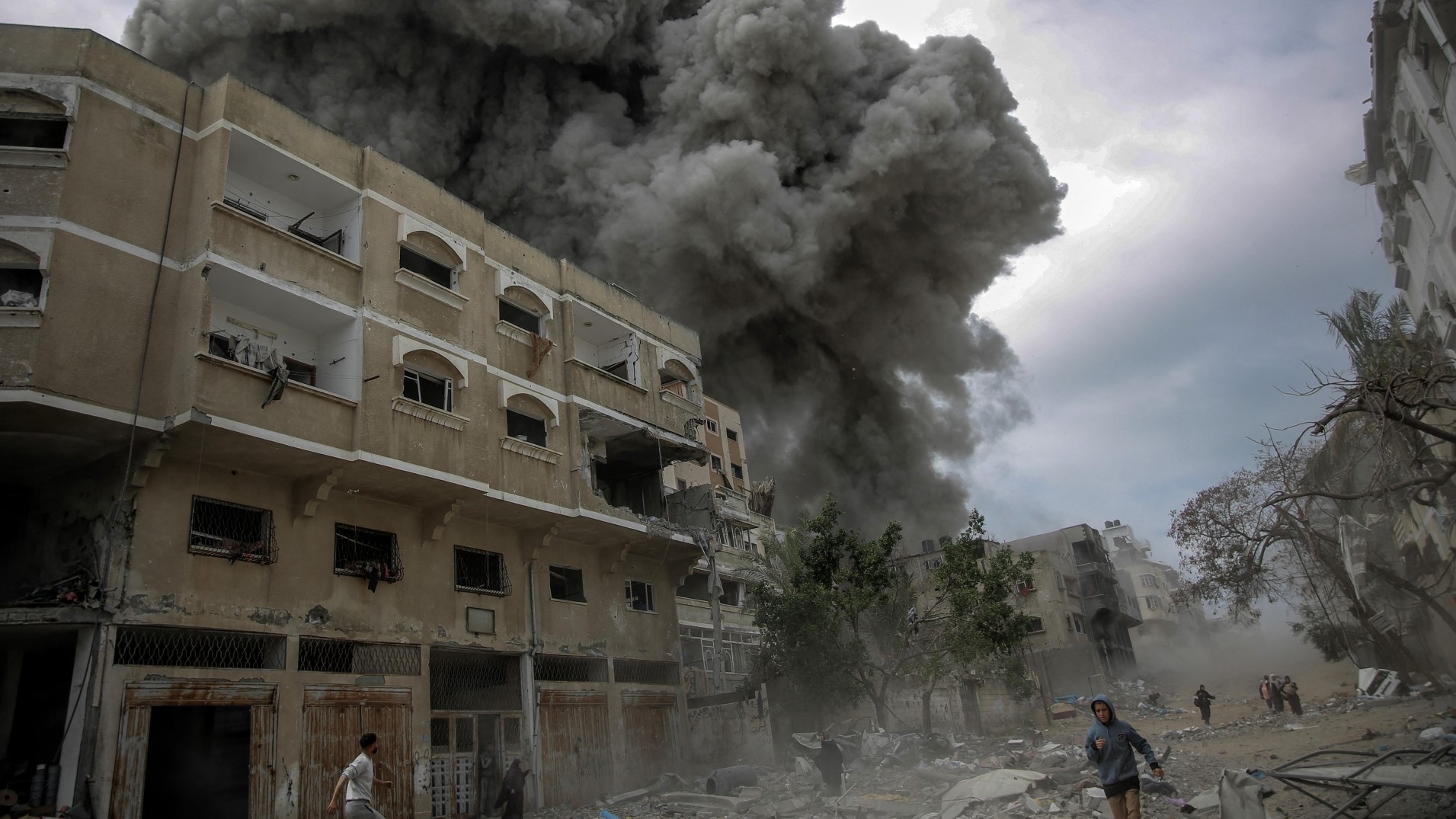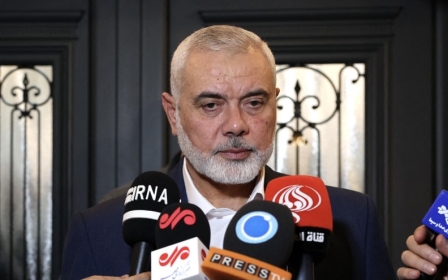Text of the Gaza ceasefire proposal accepted by Hamas

Hamas on Monday accepted a US-mediated ceasefire proposal that would see Israel halt its devastating seven-month war on Gaza and the phased release of all Israeli captives in exchange for Palestinian prisoners.
The proposal, seen by Middle East Eye, is made up of three six-week stages that lead to a permanent ceasefire, the full withdrawal of Israeli forces from the Gaza Strip and the ending of the siege.
It also includes the release of all Israeli captives held in Gaza in exchange for a number of Palestinian prisoners to be agreed upon at a later stage.
The first phase includes a "temporary cessation of military operations", the Israeli withdrawal from populated areas in the Gaza Strip, the unconditional return of displaced Palestinians to northern Gaza and the release of up to 33 living Israeli captives in exchange for approximately 1,000 Palestinian prisoners.
This phase also includes allowing the entry of 600 aid trucks into Gaza, including to the north, without restrictions.
The second phase begins with an announcement of the "return to sustainable calm (a permanent cessation of military and hostile operations)" which takes effect immediately.
According to Hamas leader Khalil al-Hayya, this means a permanent ceasefire.
Then, Hamas releases the remaining living Israeli captives, including male soldiers and civilians, in exchange for a number of Palestinian prisoners to be agreed upon during the first phase of the ceasefire.
Also during the phase, the Israeli military completely withdraws from the Gaza Strip.
In the third stage, both parties exchange the remains of dead captives and prisoners on either side.
A Gaza reconstruction plan, which should be finalised during the second phase, commences in the third phase. The proposal also includes a provision to completely end the siege on the Gaza Strip.
Here is a translation from Arabic to the full text of the proposal:
Fundamental principles for an agreement between the Israeli and Palestinian sides in Gaza for the exchange of detainees and prisoners between them and the return of sustainable calm
The framework agreement aims at: The release of all Israeli detainees in the Gaza Strip, civilians and military, alive or dead, [detained] at any time, in exchange for a number of prisoners held in Israeli jails as agreed upon; the return to a sustainable calm that will achieve a permanent ceasefire; the complete withdrawal of Israeli forces from the Gaza Strip; the reconstruction [of the Gaza Strip]; and the ending of the siege.
The framework agreement consists of three connected and interlinked phases, which are as follows:
The first phase (42 days) includes:
-
The temporary cessation of military operations between the two parties, and the withdrawal of Israeli forces eastward and away from densely populated areas to an area along the border all along the Gaza Strip, including Wadi Gaza (Netzarim corridor and Kuwait roundabout) as explained below.
-
The cessation of all aviation (military and reconnaissance) over the Gaza Strip for 10 hours a day, and for 12 hours on days in which detainees and prisoners are exchanged.
-
The return of internally displaced people to their areas of residence and the Israeli withdrawal from Wadi Gaza (Netzarim corridor and Kuwait roundabout):
-
On the third day (after the release of three [Israeli] detainees), Israeli forces are to completely withdraw from the area between the al-Rasheed Road and Salah al-Din Road, dismantle all military sites and installations in the area, displaced people begin returning to their areas of residence (without carrying weapons during their return), all residents of Gaza shall be allowed a freedom of movement across all areas of the Strip and humanitarian aid enters via the al-Rasheed Road from the first day without any obstacles.
-
On the 22nd day (after the release of half of the living [Israeli] civilian detainees, including female soldiers), Israeli forces are to withdraw from the central Gaza Strip (namely the Netzarim corridor and Kuwait roundabout) east of Salah al-Din Road and towards a zone close to the border, completely dismantle all military sites and installations, displaced people continue returning to their areas of residence in the northern Gaza Strip and the freedom of movement for the population is ensured.
-
Starting from the first day, increased and sufficient quantities of humanitarian aid, relief materials, and fuel shall enter the Gaza Strip (600 trucks daily, including 50 fuel trucks and 300 trucks designated for the North). This is to include fuel necessary to operate the power plant, restart commerce, operate heavy equipment needed to remove rubble, rehabilitate and operate hospitals, health centres, and bakeries in all areas of the Gaza Strip. This shall continue throughout all phases the agreement.
-
-
Exchange of detainees and prisoners between the two sides:
-
During the first phase, Hamas shall release 33 Israeli detainees (living or dead) who are female (civilian and soldiers), children (non-soldiers aged under 19), the elderly (over the age of 50), sick and wounded civilians, in exchange for a number of prisoners in Israeli prisons and detention centres, according to the following [criteria]:
-
Hamas shall release all living civilian Israeli women and children (non-soldiers aged under 19). In exchange, Israel shall release 30 children and women for every Israeli detainee released, based on lists provided by Hamas, in order of the length of their detention.
-
Hamas shall release all living elderly (over the age of 50), sick and wounded Israeli civilians. In exchange, Israel releases 30 elderly (over the age of 50), sick and wounded prisoners for every Israeli detainee released, based on lists provided by Hamas, in order of the longest-serving.
-
Hamas shall release all living female soldiers. In exchange, Israel releases 50 prisoners from its jails for every female soldier released (30 of whom are sentenced to life and 20 serving [other] sentences) based on lists provided by Hamas.
-
-
Scheduling of the exchange of detainees and prisoners between the two parties in the first phases:
-
Hamas shall release three Israeli detainees on the third day of the agreement, after which Hamas releases three more detainees every seven days, starting with women whenever possible (civilian and female soldiers).
-
In the sixth week, Hamas releases all remaining civilian detainees included in this phase.
-
In return, Israel shall release the agreed-upon number of Palestinian prisoners in Israeli prisons, according to the lists to be provided by Hamas.
-
Hamas shall provide information on the number of detained Israelis to be released in this phase by the seventh day (if possible).
-
The Israeli side shall releases all prisoners from the [2011] Shalit prisoner swap deal who have been re-arrested on the 22nd day.
-
If there are fewer than 33 living Israeli detainees intended for release in this phase, bodies of detainees from the same categories will be released until the intended number is reached. In return, Israel shall release all women and children (under the age of 19) who have been arrested from the Gaza Strip since 7 October 2023, provided that this is done in the fifth week of the first phase.
-
The exchange process is linked to the extent of compliance with the terms of the agreement, including the cessation of military operations, the withdrawal of Israeli forces, the return of displaced persons and the entry of humanitarian aid.
-
-
The necessary legal procedures shall be completed to ensure that freed Palestinian prisoners are not re-arrested based on the same charges of their initial arrest.
-
The basis of the number of prisoners exchanged in the first phase does not constitute a basis for the ratio of prisoners to be exchanged in the second phase.
-
Punitive measures against Palestinian prisoners and detainees in Israeli jails and detention camps that were enacted after 7 October 2023 shall be lifted, and conditions [of prisoners] shall be improved, including those who were arrested after this date.
-
No later than on the 16th day of the first phase, indirect talks shall begin between the two parties to agree on the basis for the number of prisoners to be exchanged for the remaining detainees (soldiers and remaining civilian men), which should be finalised and agreed upon before the end of the fifth week of this phase.
-
The United Nations and its agencies, including Unrwa, and other international organisations, are to conduct their work of providing humanitarian services in all areas of the Gaza Strip. This shall continue throughout all phases of the agreement.
-
Infrastructure (electricity, water, sanitation, telecommunications and roads) shall be rehabilited in all areas of the Gaza Strip and necessary equipment for civil defence to remove the rubble and debris shall enter the Strip. This continues throughout all phases of the agreement.
-
Necessary supplies and equipment to accommodate and shelter displaced people who lost their homes during the war (at least 60,000 temporary houses - caravans - and 200,000 tents) shall be allowed into Gaza.
-
Starting from the first day of this phase, an agreed-upon number (not less than 50) of wounded military personnel is allowed to travel through the Rafah crossing to receive medical treatment, and the number of travellers, patients and wounded wishing to leave via Rafah shall increase and all restrictions on the movement of goods and trade are lifted.
-
The necessary arrangements and planning shall be initiated for the comprehensive reconstruction of homes, civil facilities and infrastructure destroyed by war, as well as the compensation for those affected, under the supervision of a number of countries and organisations including Egypt, Qatar and the United Nations.
-
All measures at this phase, including the temporary cessation of mutual military operations, relief, providing shelter, withdrawal of forces, etc., will continue in the second phase until a sustainable calm (cessation of military and hostile operations) is declared.
The second phase (42 days) includes:
-
The return to sustainable calm (cessation of military and hostile operations) shall be declared and take effect before the exchange of detainees and prisoners between the two parties - all remaining living Israeli men (civilians and soldiers) - in exchange for an agreed-upon number of prisoners in Israeli jails and Israeli detention camps
-
Israeli forces shall completly withdraw from the Gaza Strip.
The third phase (42 days) includes:
-
Exchanging the bodies and remains of the dead from both sides after retrieving and identifying them.
-
The Gaza reconstruction plan over a period of three to five years - including homes, civil facilities and infrastructure and the compensation of those affected - shall begin under the supervision of a number of countries and organisations including Egypt, Qatar and the United Nations.
-
A complete end the siege on the Gaza Strip.
Guarantors of the agreement:
Qatar, Egypt, the United States, and the United Nations
5 May 2024
Middle East Eye propose une couverture et une analyse indépendantes et incomparables du Moyen-Orient, de l’Afrique du Nord et d’autres régions du monde. Pour en savoir plus sur la reprise de ce contenu et les frais qui s’appliquent, veuillez remplir ce formulaire [en anglais]. Pour en savoir plus sur MEE, cliquez ici [en anglais].




